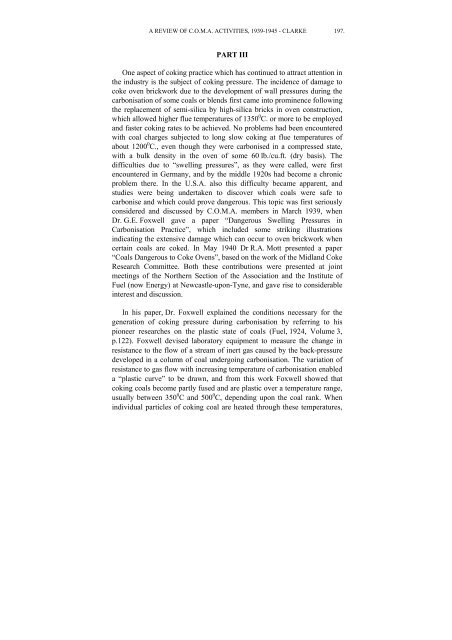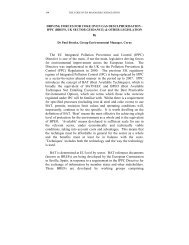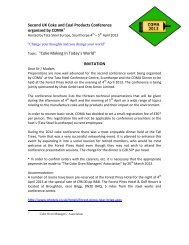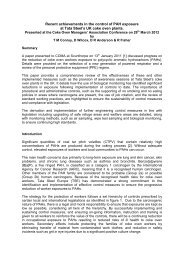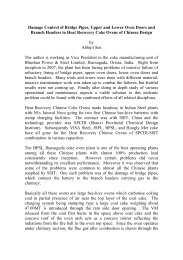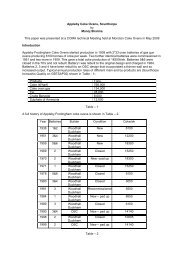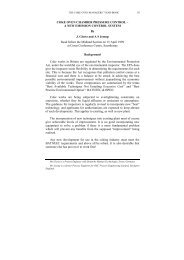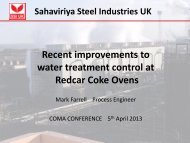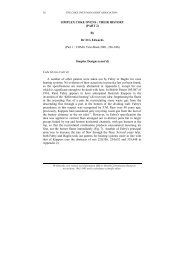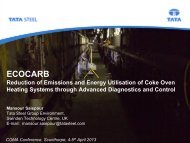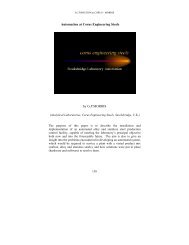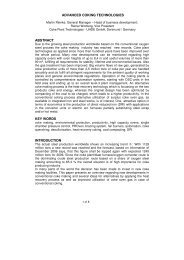CHAIRMAN'S ADDRESS - Coke Oven Managers Association
CHAIRMAN'S ADDRESS - Coke Oven Managers Association
CHAIRMAN'S ADDRESS - Coke Oven Managers Association
- No tags were found...
Create successful ePaper yourself
Turn your PDF publications into a flip-book with our unique Google optimized e-Paper software.
A REVIEW OF C.O.M.A. ACTIVITIES, 1939-1945 - CLARKE 197.PART IIIOne aspect of coking practice which has continued to attract attention inthe industry is the subject of coking pressure. The incidence of damage tocoke oven brickwork due to the development of wall pressures during thecarbonisation of some coals or blends first came into prominence followingthe replacement of semi-silica by high-silica bricks in oven construction,which allowed higher flue temperatures of 1350 0 C. or more to be employedand faster coking rates to be achieved. No problems had been encounteredwith coal charges subjected to long slow coking at flue temperatures ofabout 1200 0 C., even though they were carbonised in a compressed state,with a bulk density in the oven of some 60 lb./cu.ft. (dry basis). Thedifficulties due to “swelling pressures”, as they were called, were firstencountered in Germany, and by the middle 1920s had become a chronicproblem there. In the U.S.A. also this difficulty became apparent, andstudies were being undertaken to discover which coals were safe tocarbonise and which could prove dangerous. This topic was first seriouslyconsidered and discussed by C.O.M.A. members in March 1939, whenDr. G.E. Foxwell gave a paper “Dangerous Swelling Pressures inCarbonisation Practice”, which included some striking illustrationsindicating the extensive damage which can occur to oven brickwork whencertain coals are coked. In May 1940 Dr R.A. Mott presented a paper“Coals Dangerous to <strong>Coke</strong> <strong>Oven</strong>s”, based on the work of the Midland <strong>Coke</strong>Research Committee. Both these contributions were presented at jointmeetings of the Northern Section of the <strong>Association</strong> and the Institute ofFuel (now Energy) at Newcastle-upon-Tyne, and gave rise to considerableinterest and discussion.In his paper, Dr. Foxwell explained the conditions necessary for thegeneration of coking pressure during carbonisation by referring to hispioneer researches on the plastic state of coals (Fuel, 1924, Volume 3,p.122). Foxwell devised laboratory equipment to measure the change inresistance to the flow of a stream of inert gas caused by the back-pressuredeveloped in a column of coal undergoing carbonisation. The variation ofresistance to gas flow with increasing temperature of carbonisation enableda “plastic curve” to be drawn, and from this work Foxwell showed thatcoking coals become partly fused and are plastic over a temperature range,usually between 350 0 C and 500 0 C, depending upon the coal rank. Whenindividual particles of coking coal are heated through these temperatures,


